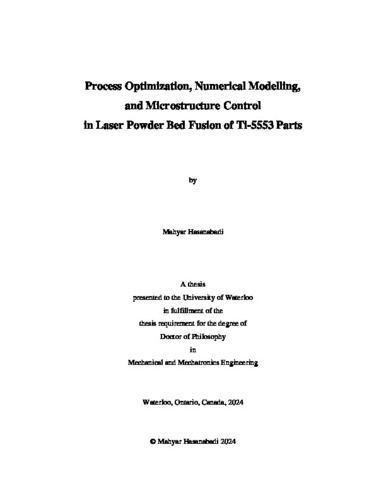| dc.description.abstract | Additive manufacturing (AM) is an advanced production technique that creates components by depositing material layer by layer. AM has been deployed industrially for producing metallic parts from alloys which pose challenges in traditional manufacturing processes like titanium alloys (Ti-alloys). While Ti-alloys are widely utilized across industries due to their exceptional strength-to-weight ratio, corrosion resistance, and toughness, machining titanium products is a complex endeavour. Laser Powder Bed Fusion (LPBF) as a metallic AM method presents an optimal solution. LPBF has been recognized as an appealing fabrication process for producing metallic parts with customized properties, however, obtaining these properties is quite challenging due to the interaction of several independent parameters. The properties of an LPBF-made product are highly dependent on the process parameters, which directly impact the melting and solidification of the molten metal. Hence, an in-depth investigation into the effect of process parameters on the melting and solidification conditions is necessary for manufacturing a high-quality product with tailored properties.
The current research deals with LPBF of a recently developed Ti-alloy, Ti-5Al-5V-5Mo-5Cr (Ti-5553). Among Ti-alloys, the β-metastable Ti-5553 offers a wide processing window, good hardenability, and excellent heat treatability, making it a preferred material in the aircraft industry. To generate an LPBF process map for Ti-5553 and assess the influence of process parameters on the properties of printed parts, an integrated single-track to multi-layer method was systematically employed. An investigation into the track morphology, melt pool geometry and melt pool microstructure composted of single-tracks was compared with a range of microscopic examinations and X-ray computed tomography measurements to multi-layer tracks to create a reliable process map. Following that, additional investigations were conducted on properties like mechanical performance and surface roughness, providing the manufacturer with additional information from each set of process parameters in order guide selection of processing parameters.
Since some aspects of solidification, such as temperature gradient and solidification rate, are not easily measurable experimentally, numerical modelling can provide an efficient solution for studying the correlation between the process parameters and the geometrical and thermal conditions of the LPBF-made melt pool. Hence, a numerical heat transfer modelling with a novel hybrid volumetric heat source has been proposed to simulate the LPBF of Ti-5553 alloy for the first time. The developed hybrid model, with an incredibly low modelling error, can predict melt pool geometry and thermal variables, at different locations and time steps during melt pool solidification to estimate many important aspects of the microstructure formation such as grain morphology, subgrain size, and grain growth direction.
The gained knowledge from the experimental and numerical analyses of melt pool solidification under various process conditions is used to propose the “laser post-exposure treatment” as an innovative method for in-situ microstructure control during the LPBF process. The laser post-exposure (PE) treatment is a secondary laser scanning with significantly lower energy input, conducted after the completion of the main laser scanning strategy on the loose powder and before spreading the new layer of powder. This in-situ microstructure control treatment results in the development of uniform, uninterrupted, and elongated grains. A printed part utilizing post-exposure can be comparable to directionally solidified products used widely in industries for enhanced creep and fatigue resistance. It should be noted that this work is the first scientific attempt to control the grain structure via in-situ laser post-exposure. | en |

